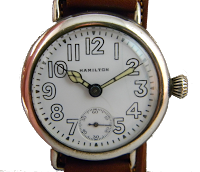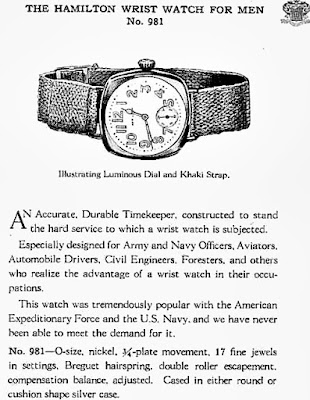Before 1914, people had difficulty with the idea of strapping a watch to one’s wrist. Manufacturers
 |
| 1917 US Hamilton 981 |
made and sold pocket watches and nothing else. People could select a case, dial and hands and a jeweler would then suggest a movement. Manufacturers of the time shipped uncased movements. That’s how they did business.
Switzerland and the United States had massive watchmaking infrastructures geared to produce a pocket watch movements. Retraining each countries workforce also presented an investment, few could justify. In Switzerland, the government enforced the village concept of specialized crafts: One company would make cases, another engraved dials and so forth.
 |
| 1915 German Issue Trench Watch |
 During the period between 1914 and 1918, war changed the way a large segment of the population used watches. That forced the watch industry to retool. Soldiers had to strap watches to their wrist and with 70 million people in the military, companies that didn’t adapt failed. This period also popularized the concept of wristwatches.
During the period between 1914 and 1918, war changed the way a large segment of the population used watches. That forced the watch industry to retool. Soldiers had to strap watches to their wrist and with 70 million people in the military, companies that didn’t adapt failed. This period also popularized the concept of wristwatches.
The watch on the left reflects the design of Mappin & Webb British field officers’ watches. It’s a Swiss watch, however, used by the German soldiers.
The watch below provides us with an example of an officer’s field watch. Notice the large luminescent Arabic numbers and hands. This watch carries a Unitas 6497 pocket watch movement and has a 44mm case. It’s a new watch shown to give one an idea of what one might look like 100 years ago.
Trench Warfare
In the initial stages of World War I, Germany attempted to outmaneuver the French and make a quick run to Paris by invading Belgium and Luxembourg heading directly toward France. The British sent an expeditionary force across the English Channel to help the French.
 The two sides attempted to outflank each other through a series of maneuvers known as a race to the sea. Neither side succeed and ended up “digging-in” in defensive positions. A stalemate began in 1914 and lasted until 1918. During this period, the combatants created elaborate trenches and attempted various kinds of tactics.
The two sides attempted to outflank each other through a series of maneuvers known as a race to the sea. Neither side succeed and ended up “digging-in” in defensive positions. A stalemate began in 1914 and lasted until 1918. During this period, the combatants created elaborate trenches and attempted various kinds of tactics.
Initially, soldiers on both sides of the WWI conflict used pocket watches often placed in a large leather sheath for the wrist.
 |
| First wristwatch in a wristlet band was only used during daylight |
The Trench watch (also called a wristlet) came into use as pocket watches were not practical in combat. The need became obvious when the armies hunkered down into muddy trenches. Obviously, infantrymen could not hold a pocket watch and load a rifle at the same time.
The first watches strapped to a wrist used a wristlet and readily available pocket watch. That proved of little use as attacks between the two sides occurred under the cover of darknesss.
As a result,
Watchmakers redesigned
You’ll see big Arabic numerals making up the hour scale. Military watches used
|
Radium dial production continued into World War II, until radiation poisoning became known. Today,
 |
| Hamilton 981 WWI Watch |
General Pershing. commander of the US forces in Europe, refused to participate in trench warfare. Hamilton did not need to make watches like the Mappin & Webb models shown above. Hamilton’s watches cases measured 1 1/6 inches or 29.6 mm.
The watch to the left is one Hamilton released in 1917. The advertisement below ran in 1919 after the war. Hamilton saw the wrist watch trend beginning to take hold in Europe and floated a trial with the 981.
Today’s Large Face Watches Using Pocket Watch Movements
It’s difficult to put a finger on the moment large face watches gained favor in this century. Ariel Adams wrote an article in his famous A Blog to Watch in which he attempts to answer that question.
Here’s a quote that may help give us an idea about large big watch sizes.
In the 1990s, the typical size for a men’s watch was in the 37-39mm wide range. A few years later that size went up to 41-44mm, and by the mid 2000s it was common to see watches sized from 45-48mm wide (and even larger). Historically men’s watches were perhaps 35-37mm wide, though in the 1970s we did see a lot of larger men’s sport watches. It is true that over time there has been a gradual trend to increase the size of men’s watches, but starting in the early 2000s, that trend rapidly accelerated.
I have my own opinion, which parallels Ariel Adams somewhat. I feel styles change over time if we wait long enough, our out-of-style clothes will become current again.
People liked pocket watches for many reasons. One of those reasons had to do with size. The railroads recognized that and required conductors and engineers to use large pocket watches with open faces.
Regardless of how the trend evolved today, history cannot ignore the role World War I and trench warfare played in the evolution of large wrist watches: The trench watch.
Copyright 2006-2017 | All Rights Reserved



